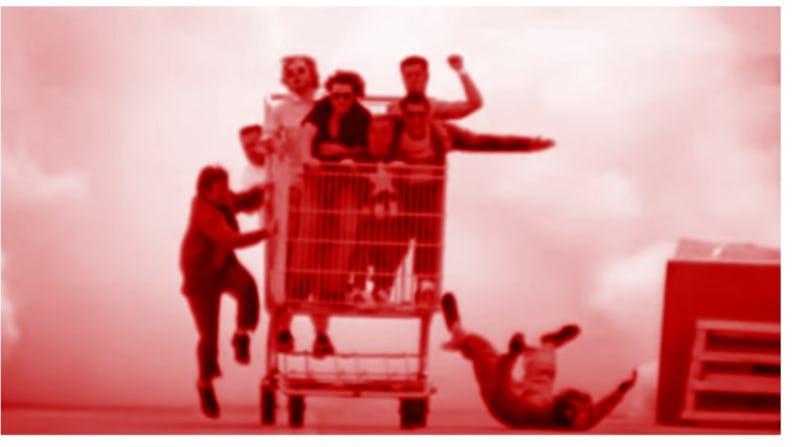For now, you can still chase online shoppers who abandon items added to cart via retargeting. But third party cookies are almost history, and the more sustainable strategy is to get in touch with your first-party data and prevent shopping cart abandonment before it happens.
So read on as we take a quick look at the current cart abandonment stats, and explain how to figure out where your site stands. Then we’ll go into the fundamentals you need to convert more customers during the checkout flow and reduce shopping cart abandonment.
Shopping cart abandonment statistics
Statistics vary in 2022, but shopping cart abandonment rates for most industries are still around 70%. For mobile, the rate is even higher.
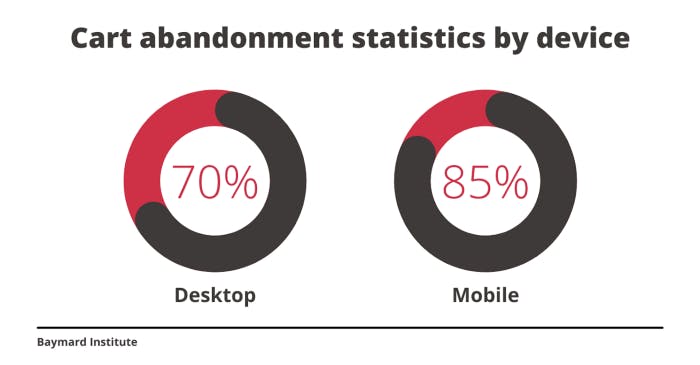
By industry, customers abandon shopping carts at more or less the same rate.
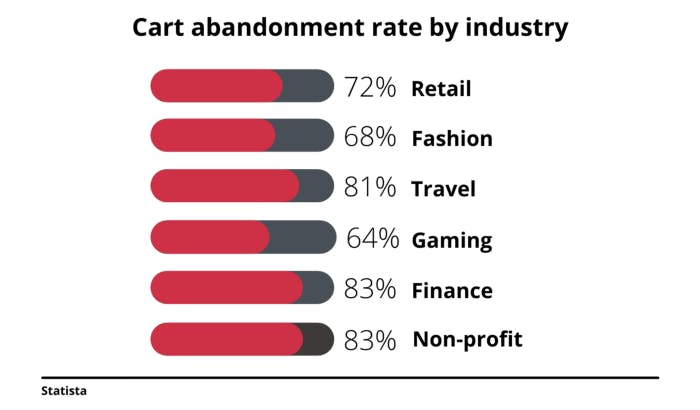
Source:
The bottom line is shoppers will always abandon shopping carts and it will always be a problem for online retailers in all industries and on all devices. And, the popularity of shopping online is only going in one direction. So how does your site fare?
How to calculate your shopping cart abandonment rate
Like ecommerce conversion rate calculation, the shopping cart abandonment rate formula is easy to use:
(One minus (the number of completed transactions divided by the number of initiated sales)) multiplied by 100
Now imagine your ecommerce store had 1680 sales (completed transactions) in December 2021 and you had 15200 abandoned carts (initiated sales). You plug the numbers into the formula and realize your shopping cart abandonment rate is high at 89 percent!
(1 – (1680 ÷ 15200)) * 100 = 89)
So your average cart abandonment rate is easy to figure out and the data to calculate it is close at hand in Google Analytics.
Using GA to track shopping cart abandonment
GA Admins can set goals to track online shopping and figure out which parts of the checkout flow are leading to shopping cart abandonment. Setting up a funnel in GA is simple, you just add the URLs of each page you want to track.
And this functionality has become even more enhanced with the Google Analytics 4 update:
Google has organized analytic reports according to the customer journey. This makes it easier to see the customer journey laid out in each step. Thus, it makes it easier for websites to track the customer journey step by step. Source: Blue Tuskr/Google Analytics 4
So with your average cart abandonment rate understood and some ideas of where cart abandonments are taking place you can begin working on reducing shopping cart abandonment.
12 fundamentals for reducing shopping cart abandonment

Besides "just browsing" the reasons shoppers abandon shopping carts are quite well known.
The top ones include high shipping costs, unexpected shipping costs, account creation, slow delivery, complicated checkout process, unclear pricing, hidden costs, hidden fees, etc. All of these and more have been cited by shoppers in the industry's biggest surveys.

Source: Baymard Institute
But first on the list most recently is the high expectation for unique online experiences.
These days, cart abandonment begins when the customer experience isn't personalized enough — especially for younger shoppers of whom 52% expect online experiences to always be personalized.
1. Personalized recommendations from first-party data
Online retailers concerned with shopping cart abandonment are paying more attention to first-party data these days because personalized recommendations have been shown to convert shoppers at a much higher rate. But which first-party data?
Traditionally first-party data has meant transactions and demographics. While these data points are still actionable, leading brands are now investing more time and energy into finding out exactly what individual shoppers want and why.
The latest personalization platforms employ AI visual recognition to analyze what product attributes shoppers prefer while they browse a site.
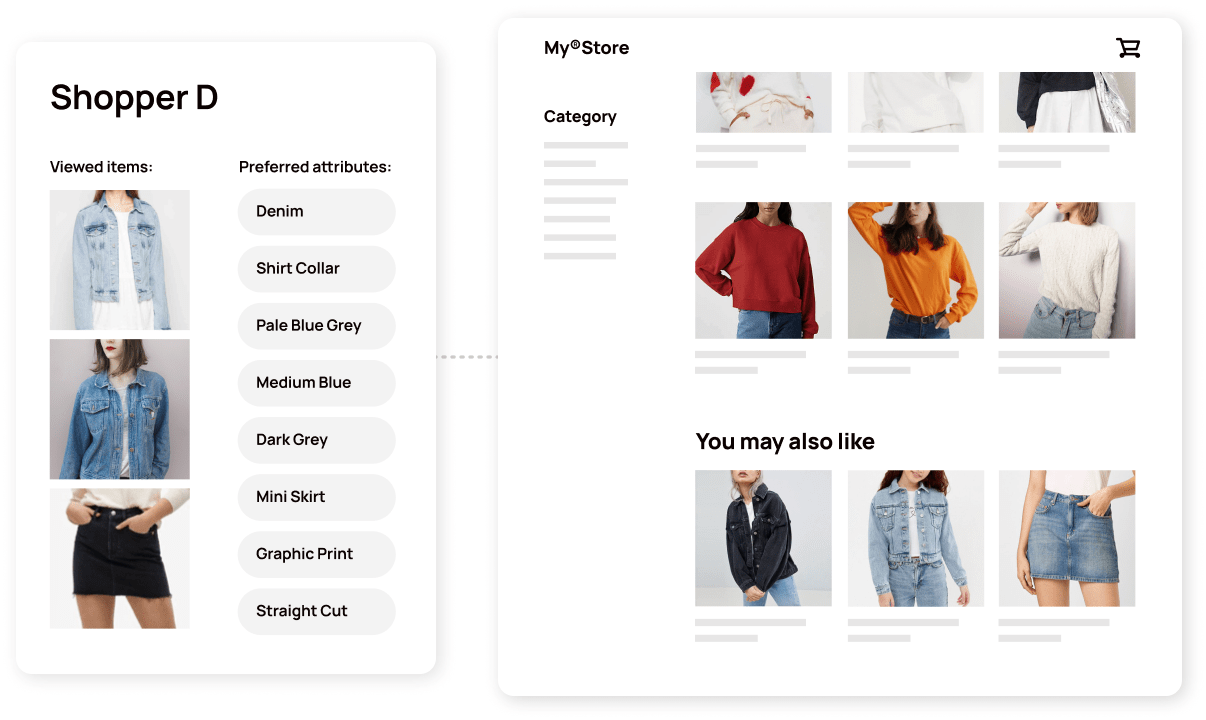
With this data in hand, the platform creates shopper preference profiles for 1-to-1, real-time product recommendations that have been shown to increase average order value by as much as 140%.
2. Use hesitant customer detection pop-ups to offer promotions
When window shoppers that have added to cart make a move to compare products they switch between product pages, and when they want to compare offsite they switch between tabs.
As these actions occur, exit-intent pop ups can be set up to make a cross-sell, offer a discount or ask for an email address.
Then, when the shopper’s browsing behavior becomes hesitant or the shopper appears to be exiting your site, the pop-up appears.
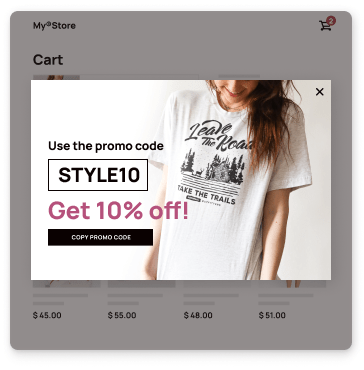
Well-timed pop-ups work better than random ones and L’Oréal has used to increase their product page conversion rates by 140%.
3. Include an add-to-wish-list button, test the wording
An option to save a cart full of items for later should be available because shoppers might leave your website with the plan to come back later to buy. Including an add-to-wish-list button is a good way to help these people and encourage them to return.
Nike calls it “Favorite.” A bit different from the much more common “add to wish list.” Also note “add to shopping cart” as opposed to simply “add to cart.” Nike has put time and money into testing the wording
Adidas uses a heart icon for “add to wishlist” and “add to cart” is “add to bag.” If you have time to test these things, they definitely matter and the most ideal wording varies according to industry and brand.
4. Introduce a community of like-minded people at checkout
Maybe your brand relates to a subculture out there. Creating a community around it can form powerful emotional connections to your brand.
And these connections build valuable brand loyalty. How many brand loyalists abandon their carts? Not very many.
The Adidas Creators Club works this way, summing up their brand image vis-à-vis Nike and offering members unlimited free shipping, returns and exchanges, access to exclusive offers, access to sport, yoga and music events, and a lot more. The invitation to the club is placed on the checkout page and offers free-shipping at the same time. Double whammy!
5. Shorten your checkout progress bar
Shoppers on a customer journey like to know where they’re at and how much further they have to go. Plus, the incomplete task motivates shoppers to keep clicking. Zara keeps it extremely simple:

The most important thing to notice on the big brand sites like Zara is that this element has become more minimalist than in years past, evolving along with the overall simplification of the checkout process.
If your checkout progress bar is more than three or four steps, your checkout design is too long.
6. Give early warnings for unexpected costs
Unexpected costs at checkout are the number one cause for shopping cart abandonment at 49%. Shipping and taxes are the two big ones and they’re difficult to avoid.
The problem is the surprise. Letting shoppers know about the shipping and taxes a bit earlier is less shocking than seeing it suddenly on the checkout page. Gucci obviously gets this and lets us know what’s up with shipping on their landing page (complimentary 2–3 day shipping)!
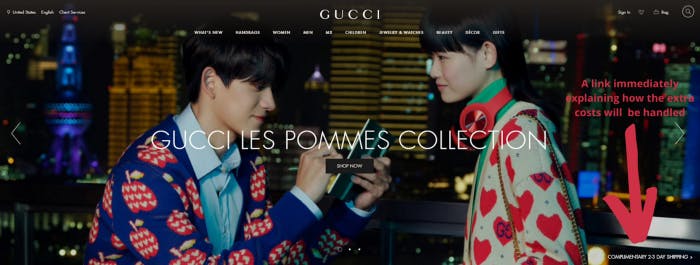
Gucci no doubt bakes the extra cost of shipping and returns into the product cost, but not all sites can afford to do that.
The worst thing is to surprise people with last second shipping costs. If you can't offer free shipping then at least provide and early warning if you want to further prevent shopping cart abandonment
7. Figure out a way to offer free shipping
Free shipping the strongest motivator to complete a purchase and sites that can do it display it prominently (as Gucci does above, ASAP).
Another way to do it is to set a minimum order value for free shipping. This not only tempts shoppers with free shipping but increases your AOV.
Besides that, Nike and Adidas both offer free shipping to members who have signed up with an email. After all, as they say, “the money is in the email list.”
8. Offer a guest checkout option
Second on the list of reasons for customers bailing out on a purchase (24%) is that they have to create an account.
Offering a guest checkout solves this problem and the little bit of extra convenience to the checkout experience goes a long way with some shoppers.
H&M provides this option right before asking you to fill out your name, email and phone number.
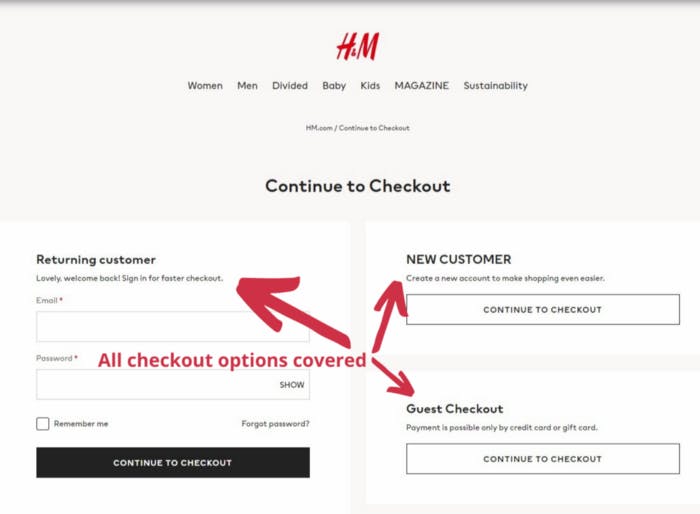
And while you don’t have them on account, you do get their email address so you can reach out to them with other offers and eventually they will more than likely become account members.
9. Signal security with visually encapsulated form design
Top brands put a lot of effort into making online transactions secure via the visual design of the credit card form.
A fascinating study by the Baymard Institute shows how visually encapsulating the design of the checkout form offers a perceived sense of security.
With borders, background colors and shading, the idea is to make one part of the form appear more robust and therefore secure.

Note the design of the Gucci checkout page above, exactly what the Baymard Institute study describes!
10. Present multiple payment options, besides credit cards
Nowadays credit cards are not the preferred payment option.
Shopping apps like Paypal have changed the game and now shoppers also expect to use digital wallets (Apple Pay, Google Pay, etc.) or virtual payment cards such as Privacy.
Shop now, pay later is also on the rise with the most popular payment methods Affirm, Klarna, and AfterPay leading the way.
11. Have a clear and easy return policy
Returns are a big part of ecommerce especially for industries like fashion where shoppers can’t judge the fit of the product they want.
When shoppers purchase online they expect that they might have to return it but an unclear process to get that done can lead to cart abandonment.
So, a clear policy on your product page can go a long way to convince shoppers that they won’t be stuck with a product they don’t want.
Two pain points that shoppers experience when it comes to returns are time limits and shipping return costs.
Managing those two things better than your competitors can help a lot.
12. Invest in a chatbot if it suits your brand
Chatbots solve problems that lead to cart abandonment in real time. Big brands like Victoria’s secret and Tommy Hilfiger have found them to be indispensable as customer engagement tools.
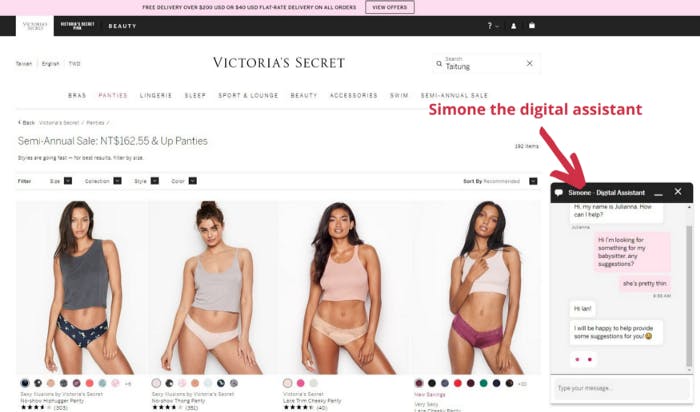
A chatbot is primarily a navigational tool, leading visitors to different parts of the website and providing general information about shipping and availability.
But for Victoria’s Secret, it really suits their brand. Employing chatbots for shoppers looking for bras provides discrete support for a delicate affair.
One last benefit of chatbots is the customer feedback. Getting to know exactly what online shoppers need at exactly the right time gives you valuable insight into how to improve your site.
Conclusion
To reduce shopping cart abandonment, leading ecommerce sites get the basics right.
They’ve put a lot of that money into testing what works for ecommerce so taking a critical look at what the leading brands are doing is worthwhile for brands of all sizes.
A lot of the things are not difficult and you can apply them yourself (visually reinforcing your credit card forms, for example).
For the more complicated things there are plenty of SaaS companies out there these days that can save you time and they serve companies of all sizes.
All the solutions are in reach nowadays. If you want to make it happen, your shopping cart abandonment fundamentals can be just as solid as the biggest brands out there







